

RV Fridge Temperature and Adjustment Guide
This post contains affiliate links.
Knowing what the temperature your RV refrigerator should be set to and how to adjust it are important to having a fun camping experience. Part of the charm of camping in an RV is having the comforts of home with you like cold food and drinks in your fridge.
Your RV’s refrigerator should be less than 40 degrees Fahrenheit (4 deg C), ideally around 35 degrees. Setting your fridge’s temperature will vary depending on the brand but adding a thermometer will help you know if your fridge is set correctly .
Learning how to adjust the setting on your RV’s refrigerator, how long it takes for your RV fridge to get cold and tips to keep your fridge cold are some of the topics I will be covering in this article.
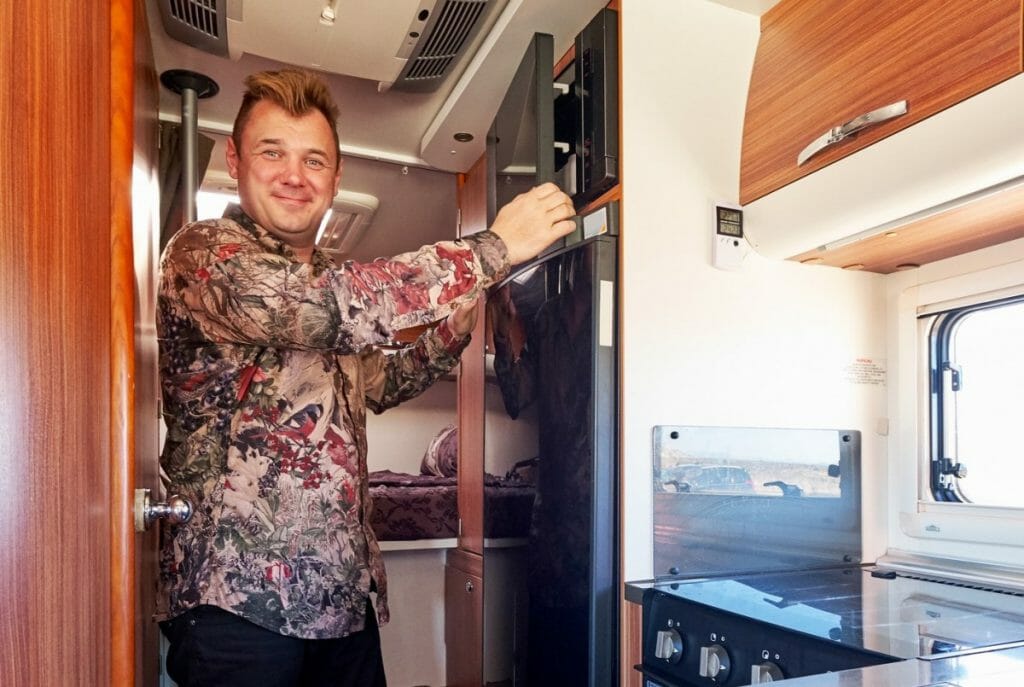
Table of Contents
Ideal Temperature for an RV Refrigerator
If you want to know the right temperature for your fridge, you have to know what temperatures your different foods need to stay fresh. Meats are best stored between 33 and 36 degrees Fahrenheit, and dairy is best stored between 34 and 38 degrees. Vegetables are best kept from 34 to 40 degrees.
Above 40 degrees is when food becomes more prone to spoiling, and bacteria growth is most rapid at 50 degrees and up. In order to keep your perishables protected you want to aim for 36 degrees Fahrenheit, or about 2 degrees Celsius, for your fridge temperature.
You may get some areas of the fridge that are warmer than others, so you’ll want to put your perishables in the coldest area of your fridge. The door of your fridge is a notorious warm spot. Having said that, if you find your milk is forming ice crystals you can try either moving it to a different location or turning up the fridge temperature slightly i.e. making it a little warmer. Here’s 12 Tips for packing an RV refrigerator.
Many fridges don’t have a specific temperature setting so it can be tricky to know what temperature your fridge is actually set to. That’s where a refrigerator thermometer comes in handy. It gives you peace of mind to know your food is safe and provides a warning if the temperature of the fridge is creeping up.

- EXTRA LARGE DIAL: The extra-large and colorful 3” analog dial makes it easy to read the measurements.
- MADE FOR DURABILITY: Constructed with a durable stainless steel casing for added strength and corrosion resistance.
- VERSATILE DESIGN: Thermometer can be hung from a rack or stand on its own in a fridge or freezer.
For your freezer, you’ll want to get it as close to 0 degrees Fahrenheit (-18 deg C) as you can in order to maximize the longevity of your frozen foods. Ice buildup can lower your freezer’s effectiveness, so make sure you defrost as needed to help keep it cold.
Here are the steps to troubleshooting an RV refrigerator that isn’t working properly.
Fix It Yourself RV Maintenance Course
The most costly parts of RV ownership are repairs and maintenance. That’s why I recommend learning to do your own RV repair and maintenance.
The Fix It Yourself RV Maintenance Course is the perfect way to learn how to do the most common repairs and maintenance on your RV. A Certified RV Technician wrote and filmed the course so you know the information is actually correct.
Plus it’s downloadable so you can access it from anywhere, even when boondocking in the middle of nowhere with no service.
Find out more about the best RV Maintenance and Repair Course available !
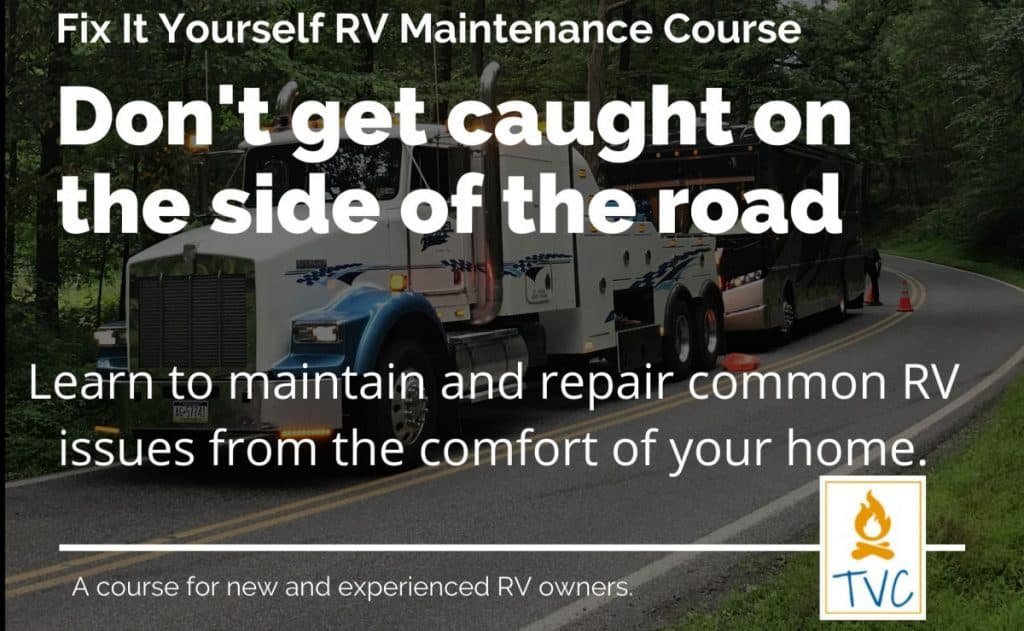
Adjusting Your RV Fridge Temperature
Sometimes it’s not that obvious how to adjust the temperature of your RV’s fridge. Many refrigerators have a dial or slider on the front but some don’t and some have ways you can further adjust them.
Aside from using a fridge thermometer, one way you can gauge whether you need to make an adjustment is if you see water inside the fridge coming from the freezer or if you have ice forming in your fridge.
Water dripping is an indication that you need to make your temperature slightly colder, while ice formation warrants increasing the temperature a little.

Changing the Setting on a Dometic Fridge
To adjust the settings of a Dometic fridge, inside your fridge there will be a lever on one of the fins, and sliding it up or down along the fin will make your fridge warmer or colder.
There may not be a very wide range – most Dometics only have settings from 1-5, but that’s where using the thermometer will help you find the right one for your fridge.
Changing the Setting on an Avanti Fridge
If you have an Avanti fridge, there will probably be a dial in the top left corner that serves as your temperature control. The higher numbers mean a colder temperature, so just turn your dial to the desired setting.
Changing the Setting on a Norcold Fridge
In a Norcold fridge, you may have to physically move the thermostat in order to adjust the temperature. Unclip the thermostat from the fin it is currently on, and clip it to another fin to the left to make it colder or another fin to the right to make it warmer.
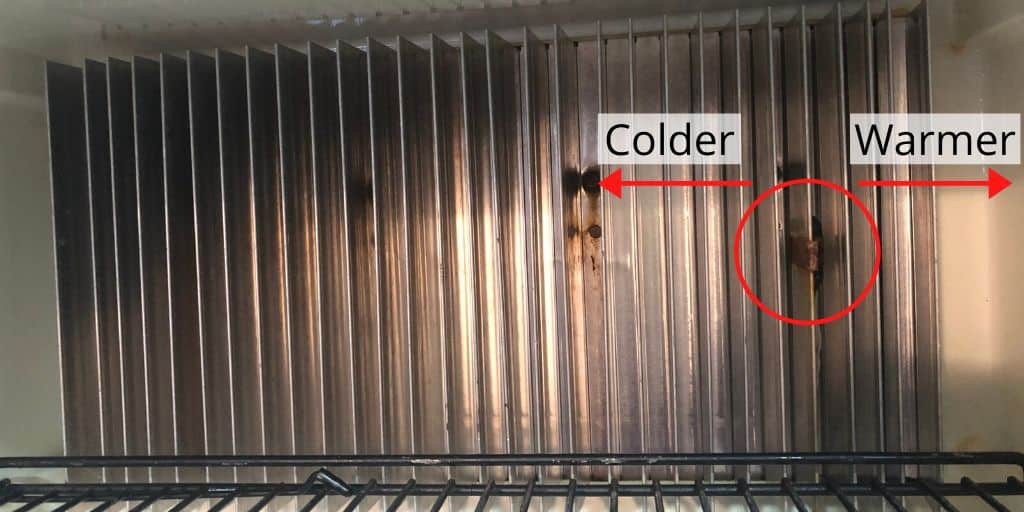
External Factors that Affect the Temperature of Your RV’s Fridge
Depending on the weather you are RV camping in, you may have to change your refrigerator settings accordingly. Hot weather outside will drive the temperature up in your fridge and cold temperatures will make your fridge get colder.
Knowing how your fridge responds to different kinds of weather will help you know when you need to make adjustments. One way to help your fridge stay cool on a hot day is to park your RV so that the fridge side is shaded.
Make sure there are no blockages in the roof and side vents of the refrigerator of your motorhome or travel trailer. Poor venting will reduce the efficiency of your fridge and it’s ability to keep your food and drinks cold. Here are some ways to check and replace your RV refrigerator side and roof vents .

Another factor is if you’re running your fridge on propane or electric. Most RV refrigerators are absorption fridges. They use heated ammonia to take heat from inside to the fridge and expel it outside. You can learn How an RV Fridge works in my detailed article.
Propane is more efficient at heating up the boiler of the RV absorption fridge cooling unit than electricity. So fridges running on propane will more easily reach a colder setting than those on electricity.
This difference between propane and electric may be enough to make you adjust accordingly, just don’t forget to reset the temperature control when you switch from shore power to propane gas. We typically have to adjust the setting on our absorption refrigerator when switching between electricity and propane.
Keeping your Food Cold in an RV Fridge
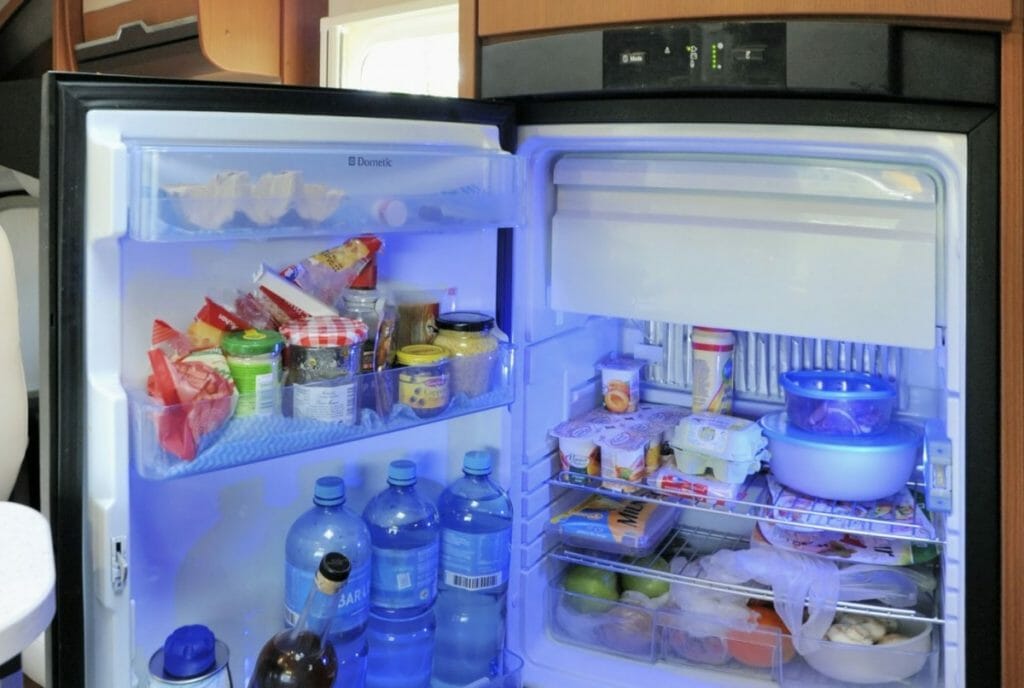
How long it takes an RV fridge to cool down and how to help it stay cool are questions we asked when we started our RV journey. As with most things the answer is it depends, and there are many different factors that will affect the cooling time for your fridge.
On average your refrigerator will cool down in 4-6 hours. There are a few tricks you can use to help it get cold a little quicker and some great ones for how to keep it cold once it reaches temperature.
When trying to figure out how long your fridge will take to cool, you have to consider what the starting temperature is. Not surprisingly a fridge that starts cooler will take less time to cool down than a fridge that starts at the outside temperature in the middle of summer.
Hot and cold weather don’t just affect the final temperature of your fridge, they will determine how long your fridge takes to cool as well.
Tips for Keeps Your RV Fridge Cold
Ensure your fridge is level.
A large contributor to the efficiency and speed of cooling is how level your parking job is. Absorption fridges use a system of tubes to circulate the refrigerant gas, and an uneven surface can cause the refrigerant to pool on one side and impede flow. This will keep your fridge from operating efficiently and can even damage it, learn more about absorption refrigerators in my article Why Your RV Fridge Needs to be Level.
Increase Circulation
Adding a small, battery-powered refrigerator fan will also cut down on your cooling time by ensuring even distribution of the cold air in your fridge. This can make hours of difference in your initial cool down time, cutting it by up to 30 percent.
A fan will also go a long way toward helping your fridge stay cool. Air circulation is a major factor in cooling efficiency, and having a fan will make your fridge’s temperature more accurately reflect its setting.

- HIGH VOLUME AIR CIRCULATOR: Enjoy fresher food longer with Camco's RV Fridge Airator! This refrigerator fan circulates air— helping cool...
- ABSORBS ODORS: Equipped with a replaceable activated charcoal pack, this RV refrigerator fan helps absorb unpleasant odors.
- COMPATIBILITY: The Fridge Airator is ideal for most small-sized refrigerators, such as camper refrigerators.
Don’t Overfill Your Fridge
One common mistake that people make is overloading their fridge. It’s tempting I know, you don’t want to leave the campsite to restock if you don’t have to, but a packed fridge will decrease circulation and raise the temperature, putting all that amazing food you just bought at a higher risk for spoiling.
Making sure there is room for proper circulation will help your fridge stay cold. That fridge fan I mentioned above will really help on your next RV camping trip.
Don’t Put Hot Food in the Fridge
Another thing to keep in mind is that putting warm or room-temperature things into your fridge will also raise its temperature. If you’re putting large amounts of leftovers inside, make sure they have cooled down so you aren’t heating up the inside of your fridge. You may want to lower your settings temporarily or stagger the timing of when you put a new dish in.
Don’t Leave the Fridge Door Open
When you go to get something out of your fridge, you want to get in and out as quickly as possible. Leaving the door open will cause you to lose more and more of your precious cool air, so having an idea of what you’re getting ahead of time will keep your fridge cooler.
Let Your Fridge Get Cold Before Your Trip
Turning on your fridge before your trip will save you the 4-6 hours of cool down once you get to your destination and packing it with already cold food from your home’s fridge will help too. Another trick you can use to cool down your fridge as you’re traveling is to put ice packs inside that you can later transfer to your freezer.
Check Your Fridge Door Seals
Something else that may be working against your refrigerator is the very thing designed to keep it from losing cold air – its door seal. Door seals can easily become damaged, and even a layer of grime on the rubber can keep it from forming a proper seal. Here’s the b e s t way to clean an RV refrigerator .
Your cold air could be leaking out of your fridge right underneath your nose from a bad seal, so making sure you consistently check now it will keep you from scratching your head later wondering why your refrigerator won’t stay at the temperature you set.
Closing Thoughts
Setting the right temperature for RV refrigerator and then getting it to stay there can seem like a challenge, but with some knowledge and a few tricks, you can get your fridge and it’s contents to stay nice and cold.
Recommended RV Fridge Gear

- Keep order in the RV refrigerator and cupboards during travel.Fit Type: Universal Fit
- Spring loaded bars keep items in place
- Refrigerator bars extend from 16" to 28"
Diane is a lover of all things travel. She and her young family wanted to explore North America from the comfort of their own home so they bought an RV. After fully rehabbing a 1994 Safari Trek, they set out to explore both Canada and the USA.
Recent Posts
Why You Need to Disconnect Your RV Battery When Not In Use
It's always fun to get the RV ready for another adventure after it's been in storage but what isn't fun is finding out your house batteries are dead. Without your house batteries, most of the...
Best Campgrounds in Yellowstone National Park for RVs
Yellowstone National Park is one of those places that should be on your bucket list. And one of the best ways to get there and enjoy the park is in your RV. Whether you are looking for a full...

- French Door
- Side-by-Side
- RV Refrigerator Troubleshooting
- Affiliate Disclaimer
- Privacy Policy
How to Adjust RV Refrigerator Temperature: Tips for Optimal Cooling
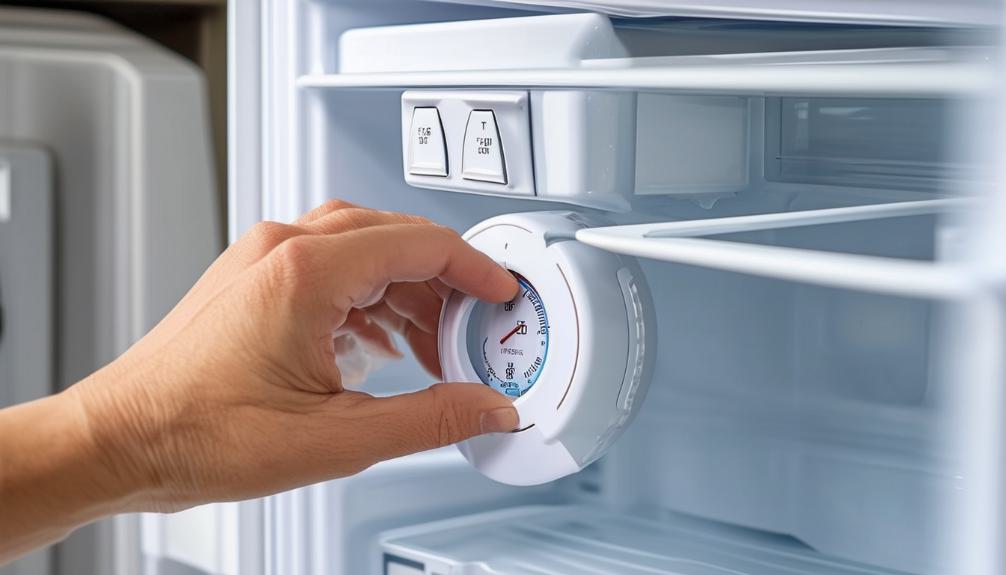
When dealing with maintaining your RV refrigerator at the ideal temperature for best cooling, mastering the adjustments is essential. By grasping how to fine-tune the settings and apply some straightforward yet efficient strategies, you can guarantee your food stays fresh and secure during your journeys. But there’s more to it than just adjusting a dial – factors like ventilation and leveling play a vital role in the cooling process. Stay tuned to uncover the insider tips that will enhance your RV refrigeration game.
Why Adjust RV Refrigerator Temperature
Adjust your RV refrigerator temperature to keep your food fresh and safe to eat. Signs that you need to tweak the temperature include food spoiling quickly, uneven cooling , or ice forming where it shouldn’t.
Watching out for these signs can help you avoid food waste and keep your refrigerator running efficiently.
Importance of maintaining optimal temperature
Keeping your RV refrigerator at the right temperature is crucial for food safety and freshness during your travels. Proper temperature control prevents bacteria growth, keeps perishables in good condition, and makes sure your food stays safe to eat.
Here’s why it’s important to maintain the correct temperature in your RV refrigerator:
Signs that your RV refrigerator temperature needs adjustment
To ensure your RV refrigerator is working efficiently, look for specific signs that the temperature might need adjusting . If your food is freezing or items are overly icy, the temperature might be set too low. Conversely, if your food is spoiling quickly or not staying fresh, the temperature could be too high.
Uneven cooling, where some areas are colder than others, also indicates that adjustments are needed. Unusual sounds coming from your fridge can signal temperature regulation problems.
Stay alert to these signs to keep your RV refrigerator at the optimal temperature for cooling and preserving food.
How to Adjust RV Refrigerator Temperature
To adjust the temperature of your RV refrigerator, follow these steps:
- Find the temperature control panel.
- Set the temperature to your preferred level using the colder-warmer settings.
- Use a thermometer to check the temperature inside the fridge.
- Tweak the settings as needed.
Make sure to monitor the temperature regularly to ensure your food stays fresh and safe.
Finding the temperature control
To adjust the temperature of your RV refrigerator, find the control panel with the colder-warmer settings. Here’s how to locate and use it:
- Open the refrigerator and look for a small panel inside.
- Find a dial or slider marked with colder on one end and warmer on the other.
- Turn the dial or slide the control to set the temperature to your preference.
Proper temperature control ensures your food stays fresh and prevents spoilage.
Adjusting the temperature settings
Find the control panel inside your RV refrigerator to adjust the temperature settings effectively. Look for the controls typically marked with symbols like snowflakes for colder and suns for warmer settings.
Turning these controls lets you fine-tune the temperature to keep your food fresh and properly chilled.
Make gradual changes and give the refrigerator time to reach the new setting before making further adjustments. This helps avoid overshooting the desired range.
Aim for a temperature between 37-40 degrees Fahrenheit to ensure food safety and longevity.
Using thermometers to monitor temperature
To adjust your RV refrigerator temperature effectively, use thermometers to monitor the internal temperature accurately. Here are three key reasons why using thermometers is beneficial:
- Accuracy : A thermometer gives you precise readings of your fridge’s internal temperature. This helps you adjust the settings to maintain the ideal cooling range of 37-40 degrees Fahrenheit .
- Monitoring : Regularly checking the thermometer allows you to keep an eye on temperature fluctuations. This ensures your food remains fresh and safe to eat.
- Troubleshooting : If you notice temperature inconsistencies, a thermometer can help pinpoint issues like a malfunctioning cooling unit or poor airflow.
Using thermometers alongside adjusting your RV refrigerator’s temperature settings can improve cooling efficiency and extend the appliance’s lifespan.
Tips for Optimal Cooling
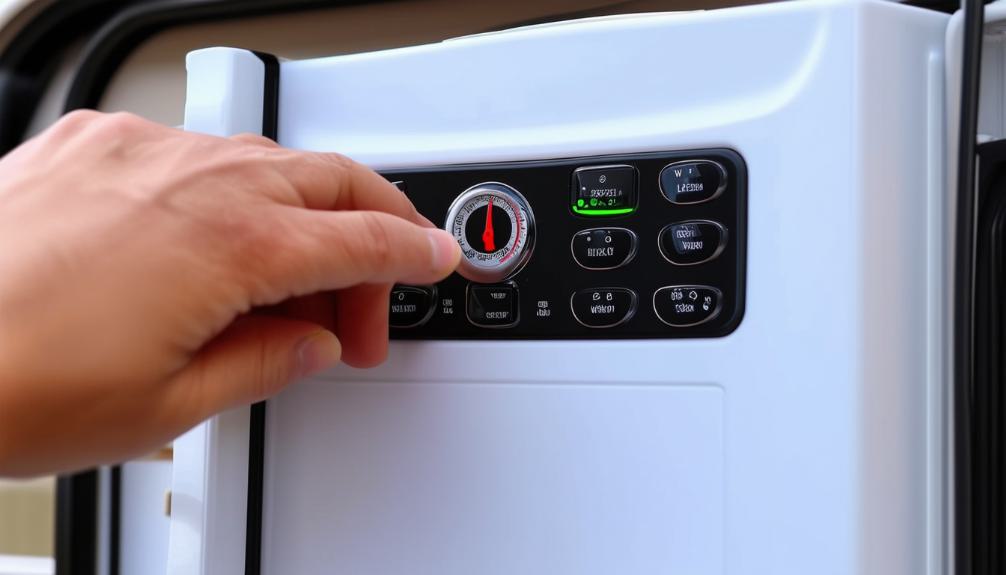
For the best cooling in your RV fridge , make sure there’s good ventilation so air can flow around it.
Keep your RV level to avoid uneven cooling .
Don’t overload the fridge to keep it efficient, and clean it regularly to keep it running smoothly.
Proper ventilation
Optimize Ventilation for Your RV Refrigerator
Proper ventilation is crucial for keeping your RV refrigerator running efficiently and effectively. Follow these three practical steps to ensure your fridge stays well-ventilated:
- Clear the Space : Leave a few inches of space around your refrigerator to allow for good airflow. Avoid placing any items or obstructions in front of the vents that could block air circulation.
- Inspect the Vents : Regularly check the exterior vents of your RV refrigerator. Make sure they’re clean and free from dirt, dust, or debris. Use a soft brush or cloth to remove any buildup that could restrict airflow.
- Use Ventilation Aids : Consider adding vent fans or baffles to improve airflow around your fridge. These aids can be especially helpful in hot weather or if your RV is parked in direct sunlight for long periods.
Proper ventilation keeps your RV refrigerator running smoothly, ensuring your food stays cool and fresh.
Leveling the RV
Make sure your RV is properly leveled to keep your refrigerator cooling efficiently. If your RV isn’t level, your fridge might not work right, causing cooling problems. To fix this, use a leveling tool to check that your RV is on an even surface. Here are some practical tips for leveling your RV:
Keeping your RV level not only helps your refrigerator but also ensures a more comfortable living environment.
Avoiding overloading the refrigerator
Keep your RV refrigerator running efficiently by organizing its contents wisely. Here’s how to avoid overloading it:
- Use shelves smartly: Place taller items at the back and shorter ones at the front. This setup helps air circulate better, keeping everything cool.
- Leave gaps between items: Space out your food to let cold air flow freely. This way, all items get cooled evenly.
- Invest in bins or organizers: Use bins to group similar items. This makes it easier to find what you need and cuts down the time the fridge door stays open.
Regular maintenance and cleaning
To keep your RV refrigerator running efficiently, make regular maintenance and cleaning a priority. Dust, dirt, and debris can gather on the coils at the back, making it harder for the fridge to cool. To prevent this, vacuum or brush off any buildup on the coils periodically. This ensures they stay clean and work effectively.
Check the door seals for wear or damage. A tight seal is crucial for proper cooling. If you spot any issues, replace the seals right away. Regular defrosting is also important. Ice buildup can insulate the cooling elements, causing them to work harder to keep your food cold. By removing ice regularly, you help the refrigerator maintain its cooling efficiency .
Troubleshooting
If your RV refrigerator is having temperature issues , like fluctuating or running too cold, it’s important to tackle these common problems right away.
By identifying these issues, you can effectively adjust the temperature settings for optimal performance.
Pay attention to any error codes and look for potential causes such as heating element failures or seal leaks to keep your refrigerator running efficiently.
Common issues with RV refrigerator temperature
Experiencing issues with your RV refrigerator temperature can often be linked to common malfunctions affecting its cooling efficiency . Here are some typical problems you might face:
- Refrigerator running too cold: If your fridge is freezing your food, it could damage both the food and the unit. This often points to a malfunctioning thermostat or a stuck control board.
- Inconsistent cooling: Temperature fluctuations inside your refrigerator can cause uneven cooling, leading to potential food spoilage. This issue might be due to a faulty thermistor or blocked airflow.
- Warm refrigerator: If your refrigerator isn’t cooling properly, it might be due to problems with the cooling system, such as low gas pressure or a malfunctioning heating element. This can result in food not being stored at safe temperatures.
How to address temperature fluctuations
To tackle temperature fluctuations in your RV refrigerator , follow these practical steps to maintain optimal cooling performance.
First, ensure there are no obstructions around the refrigerator vents , as proper airflow is crucial for effective heat escape.
Check the door seals for any gaps or damage that might allow warm air to seep in, causing temperature inconsistencies.
Adjust the temperature settings gradually and give the fridge time to stabilize between changes.
If the problem continues, clean the condenser coils to boost cooling efficiency.
Also, inspect the cooling fins and evaporator coils for ice buildup, which can interfere with the cooling process.
Frequently Asked Questions
How does the thermistor affect the refrigerator temperature.
The thermistor, an essential component, directly affects the refrigerator temperature. It measures the internal temperature, sending data to the control board. This information guides the system in adjusting the cooling process to maintain the desired temperature range effectively.
Can the Control Board Be Reset to Fix Temperature Issues?
Yes, you can reset the control board to fix temperature issues. Locate the reset button or power cycle the refrigerator to reset the control board. This simple step can often resolve temperature problems and restore proper cooling functionality .
What Is the Purpose of the Heating Appliance in the Fridge?
The heating appliance in the fridge helps prevent frost buildup by evaporating excess moisture. It cycles on and off to maintain ideal humidity levels. If it malfunctions, frost can accumulate, affecting cooling efficiency.
Is It Normal for the Fridge Temperature to Fluctuate?
Yes, it’s usual for your RV fridge temperature to fluctuate slightly due to factors like outside temperature changes or opening the door frequently. Keep an eye on it to make sure it stays within the best cooling range.
How Often Should the Refrigerator Seals Be Checked for Leaks?
You should check the refrigerator seals for leaks at least once a year. Use a dollar bill test: close the bill in the door and try to pull it out. If it slips easily, it’s time for new seals.
Now that you know how to adjust your RV refrigerator temperature for best cooling, remember to regularly monitor and maintain it to ensure efficiency.
By following these tips, you can avoid food spoilage and keep your fridge running smoothly during your travels.
Happy camping!
Related Posts
- How to Remove RV Fridge Panels: Easy Guide
- RV Refrigerator Will Not Cool? Troubleshoot Common Issues Here
- How Many Watts Does an RV Refrigerator Use? Find Out Now!
- Smad 2.1 Cu.Ft Propane RV Refrigerator Review: Honest Opinion
- How to Remove an RV Refrigerator? Step-by-Step Guide
rvrefrigerator
Leave a reply cancel reply.
You must be logged in to post a comment.

- Types Of RVs
- Tow Vehicles
- Maintenance & Repairs
- RV Power & Electrical Supplies
- RV Appliances
- Living In An RV
- Travel & Destinations
- RV Gear Buyer’s Guides
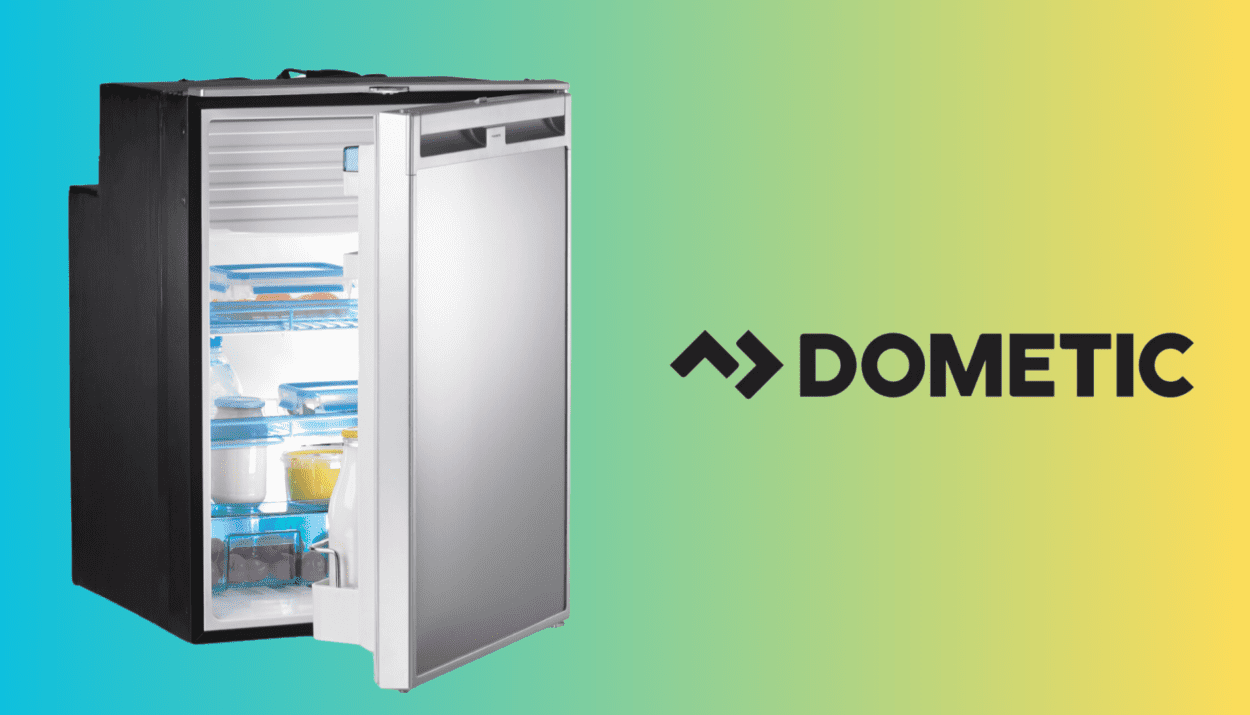
How To Adjust The Temperature On A Dometic RV Refrigerator
- Last Updated: October 2, 2024
- 8 minutes read
Adjusting the temperature on your Dometic RV refrigerator varies slightly depending on your specific model. Some refrigerators have buttons with a 1-5 temperature scale. Others are factory preset and only allow minor temperature tweaks using a manual knob.
I remember the first time I tried to change the temperature in my Dometic RV refrigerator. At first, I cranked the refrigerator temp down as low as possible. It took me a while to finally learn how the Dometic fridge temperature control works.
You don’t have to go through the same ordeal I did. So, in this article, I’ll walk you through the different types of temperature controls found on RV refrigerators, answer some of the most common queries, and provide valuable tips on how to adjust temperature on Dometic RV Refrigerator.
How Dometic RV Refrigerators Work
Dometic RV refrigerators use an absorption process to cool the refrigerator’s interior. This process involves separating a mixture of ammonia and water using heat. The heat source can be electric heating elements or an LP gas flame. The heat causes the ammonia to boil and turn into a gas, while the water remains a liquid.
The ammonia gas flows through a series of coils, where it cools and condenses back into a liquid. This process of boiling and condensing the ammonia removes heat inside the refrigerator, cooling it down.
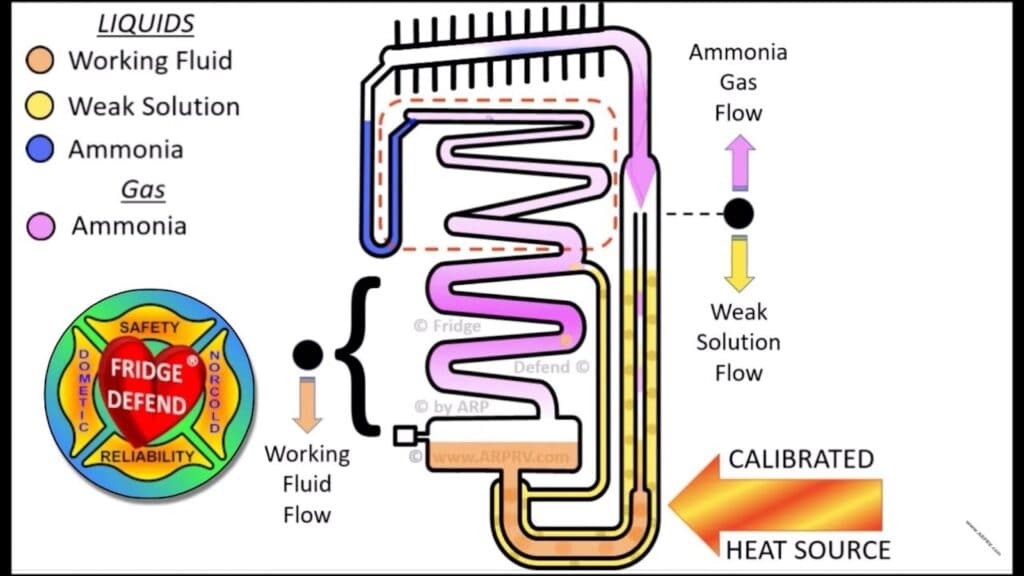
When You Need To Adjust Your Dometic RV Fridge Temperature
Adjust the temperature settings in the following situations:
- Using the Dometic RV fridge for the first time: The ideal interior fridge temperature is around 40°F. Adjust the dial gradually and allow the temperature to stabilize before making additional changes.
- Temperature is too warm: The interior temperature is likely too high if your fridge is not cooling properly, with soft or melting food items. Adjusting the dial to a cooler setting should lower the temperature and better preserve your food items. Check with a thermometer to confirm the new temperature is in the recommended range.
- Temperature is too low: The temperature is too low if food items are freezing inside the fridge compartment. Adjust the dial slightly towards a warmer setting until foods are cold without freezing.
- Outside temperature changes: Significant shifts in the exterior temperature can impact your RV fridge’s interior temperature. When camping in hot or cold weather, adjust the temperature dial according to the exterior conditions.
- The fridge is full: The ideal temperature also depends on how full your fridge is. A heavily stocked fridge will require a colder setting than an emptier one and vice versa.

Adjusting Temperature in Dometic RV Fridges With Buttons
Some Dometic RV refrigerator models have buttoned temperature controls, with buttons ranging from 1 to 5, instead of a manual dial. With these button controls, the available temperature range is more limited. However, you can still fine-tune the setting to suit your needs.
Here is how to adjust the temperature on a Dometic RV refrigerator with buttons:
- Locate the temperature control buttons at the front of the refrigerator.
- Press the buttons to increase or decrease the temperature according to your requirements and allow time for the temperature to stabilize before making additional changes.
- Remember that higher numbers indicate colder temperatures. Setting 5 will be the coldest option.
- I often find that Setting 4 works perfectly to keep food chilled but not frozen. This seems to be the “sweet spot” for most RV owners.
- Try starting at the middle number 3. Monitor the temperature for a few hours. If it is still too warm, adjust it up to 4. If it is too cold, adjust to 2.
- The ideal setting depends on factors like how full the fridge is. For instance, a packed fridge will require a higher cold setting than an emptier one.
With some testing and adjustment, you’ll find the right button setting to keep your Dometic RV refrigerator at just the appropriate chilled temperature.
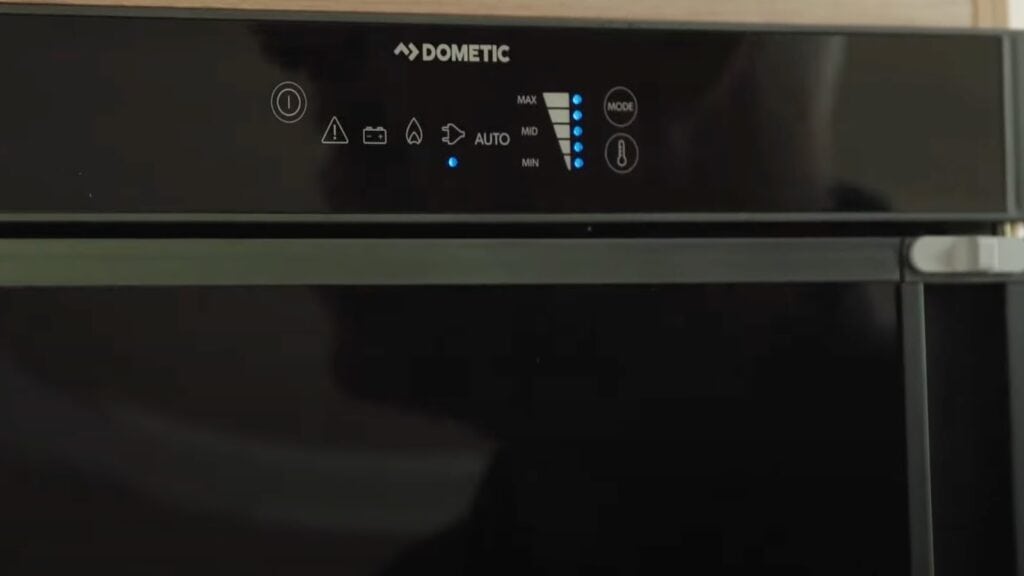
Adjusting Temperature in Dometic RV Fridges Without Controls
Some older Dometic RV refrigerator models do not have adjustable temperature controls. Instead, they rely on a thermistor to regulate temperatures automatically.
The thermistor is a temperature sensor clipped onto the cooling fins inside the fridge compartment. It feeds data to the fridge thermostat, which turns the cooling on and off to maintain target temperatures.
You can adjust the overall fridge temperature slightly by repositioning the thermistor:
- Locate the thermistor clipped onto one of the fridge fins.
- Moving the thermistor upwards makes the fridge cooler. Remember this by thinking that going North will take you to colder regions.
- Lower placement makes it warmer. Remember this by thinking that going South will take you to a warmer region.
- Allow the temperature to stabilize for a few hours after moving the thermistor.
- Check the new temperature with a thermometer. Adjust again if needed.
- Moving the thermistor will change the fridge temperature by around 6-8°F.
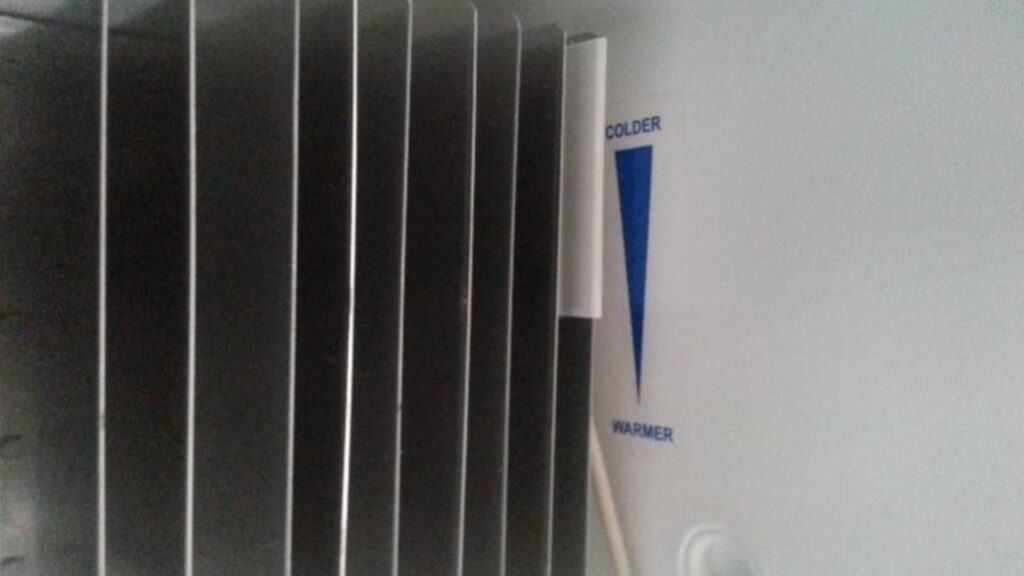
Tips For Efficient RV Dometic Refrigerator Cooling
Properly cooling food and beverages in an RV refrigerator requires special care and attention. A few key tips can ensure your Dometic RV fridge works efficiently to maintain the desired interior temperature. Doing so will save energy and reduce strain on the unit.
- Keep the RV level when parked: Parking on an uneven surface can disrupt the absorption cooling system in Dometic RV refrigerators. The fluids may not circulate properly through the coils, reducing efficiency. Park on a flat, level site so the fridge can work efficiently.
- Ensure good airflow to the exterior vents: Airflow over the condenser coils is critical for venting heat outside the unit. Keep the exterior vents clear of obstructions like insect nests or debris. Good airflow enables the fridge to work with less effort.
- Allow the fridge to cool fully before loading: Turning on the RV refrigerator well before loading food allows the interior to chill to the proper temperature. Starting with an already-cold environment prevents temperature dips when you add food items. Ideally, switch on and let the fridge get cold for 24 hours before filling it with food.
- Install an interior air circulation fan: A small DC muffin fan can circulate the air inside an RV fridge to maintain an even Dometic fridge temperature from top to bottom. Consistent cold air flow over stored food is vital for optimal cooling.
- Avoid overloading the refrigerator: Too much food prevents cold air from properly circulating and makes the fridge work harder. Leave some space inside so the cooling system is not overloaded or strained.
- Minimize opening the door: This one’s a no-brainer. Opening the door frequently allows cold air to escape and warm air to enter. Only open when necessary to take items out or put items in. Keeping the door closed as much as possible saves energy and provides better cooling.
- Use accessories to enhance cooling: Vent covers, interior fans, and thermometers tailored to RV fridges can help optimize airflow and monitor interior temperature. Such accessories lead to more efficient Dometic fridge temperature control. If your fridge is still not getting cold, read more here .
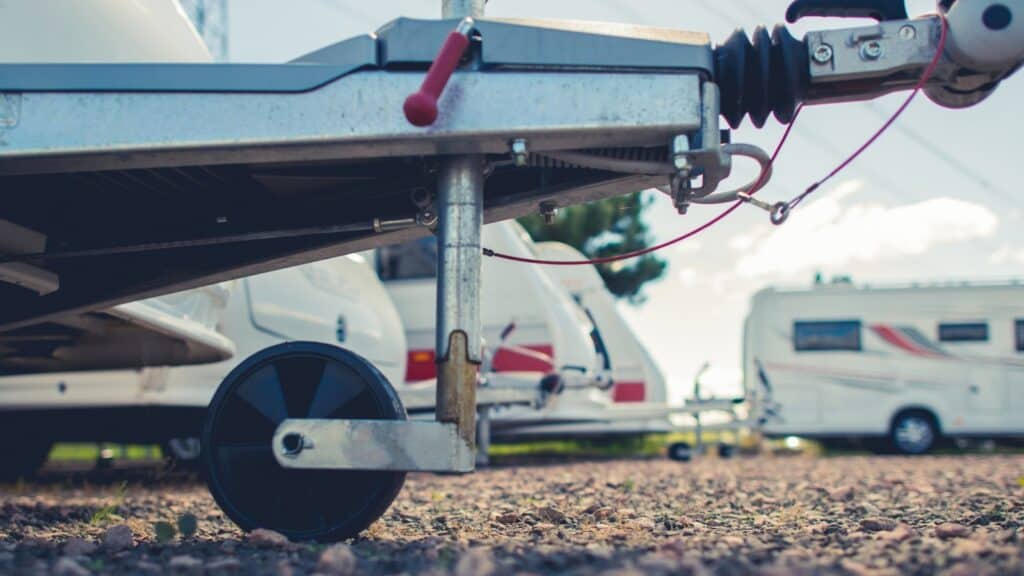
Just so you don’t get lost in the technicalities, here is a table summarizing all the major details I’ve covered till now:
What is the recommended temperature for a Dometic RV fridge?
The optimal temperature range for a Dometic RV refrigerator is 35-42°F (1.6-4.4°C). Aim to keep the interior around 40°F for proper food safety and to prevent spoilage. This allows cold enough temperatures without freezing items.
How do I adjust the temperature on my Dometic RV fridge?
To change the temperature, look for a small white plastic knob or lever on one of the interior fins. Gently move this knob up to make the fridge colder or down to make it warmer. Alternatively, in Dometic fridge models with buttons or a digital meter, you can choose a level from 1 to 5. Make adjustments in small increments and allow time for the temp to stabilize.
How can I tell if my Dometic fridge temperature is too cold or hot?
Place an appliance thermometer inside the RV fridge to monitor the exact temperature. If it’s warmer than 42°F, adjust the knob to make it cooler. If it is colder than 35°F, adjust it to slightly warmer.
What is the normal temperature range for a van refrigerator?
The standard interior temperature for a van refrigerator typically ranges from 35-40°F. However, optimal temperature depends on the specific refrigerator model, capacity, and outside ambient temperatures. Check the manual for your particular van fridge.
How long does a Dometic RV fridge take to cool down?
A Dometic RV refrigerator can take 4-24 hours to cool down to safe food storage temperatures. The time depends on the fridge’s starting temperature and capacity. Allowing 24 hours for the fridge to chill is recommended, especially in hot weather. This ensures the interior reaches the ideal 35-40°F before you load in food items.
About Author / Aaron Richardson
Aaron Richardson is an expert RVer and the co-founder of RVing Know How. Aaron, along with his wife Evelyn, has been living and traveling in their Keystone Fuzion RV since 2017. Their adventures span across the country and beyond, including memorable RVing experiences in Mexico. Aaron's passion for the outdoors and RVing shines through in his writings, where he shares a blend of travel stories, practical tips, and insights to enhance the RV lifestyle.
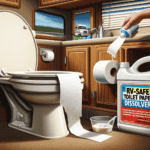
How To Dissolve Toilet Paper In RV
How to open rv windows (step-by-step guide).

Leave a Comment Cancel reply
Your email address will not be published.
Save my name, email, and website in this browser for the next time I comment.
You Might Also Like
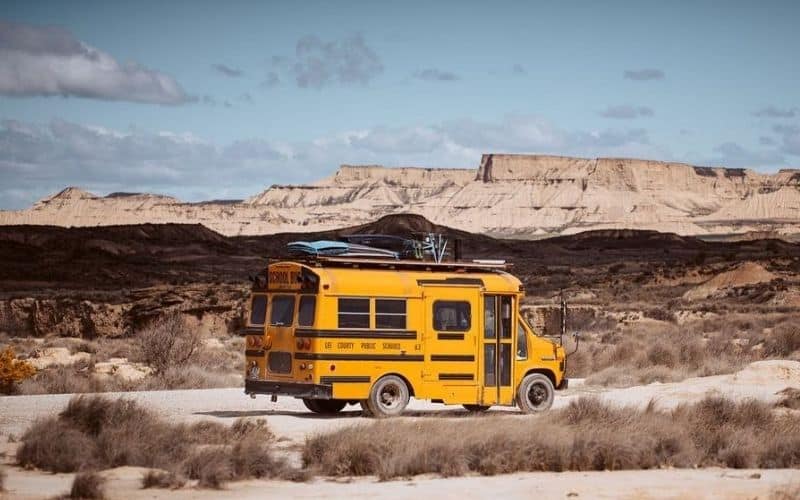
Reasons to Avoid Skoolies & Bus Conversions For Living On The Road

Can The 2022 Ford Escape Tow A Camper Trailer?
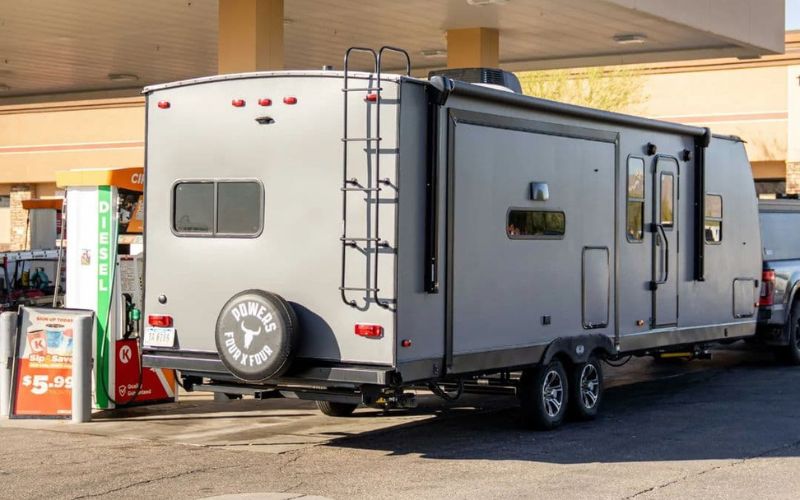
RV Spare Tire Mount: Options For Carrying Your Spare Wheel
Start typing and press Enter to search

What Temperature Should My RV Fridge/Freezer Be?
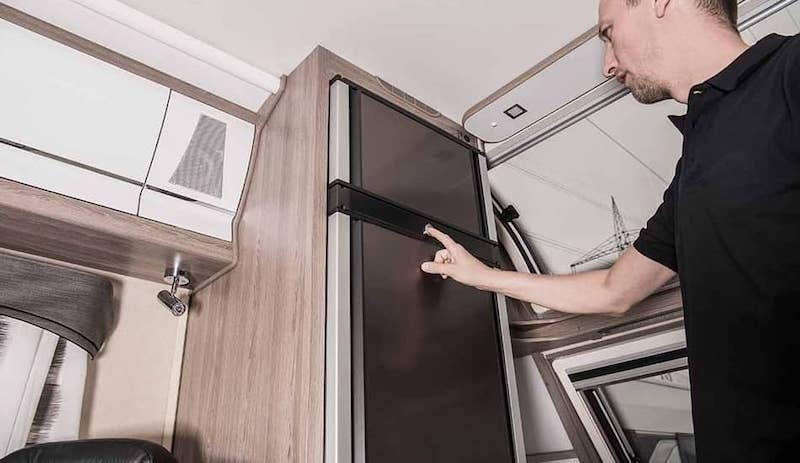
Sharing is caring!
Thanks for your support! If you make a purchase using our links in this article, we may make a commission. And, as an Amazon Associate, I earn from qualifying purchases. See the full disclosure here .
Updated May 6, 2024
The temperature of your RV fridge/freezer is a common challenge faced by avid travelers on the road. But on average, your RV fridge temp should range between 34 and 40 degrees, and your freezer temp should be zero or lower.
Maintaining the right RV fridge temperature is of utmost importance.
It directly impacts the quality, freshness, and safety of the food we store, ensuring our meals remain delicious and our beverages stay refreshingly cool.
So, what magic number will keep your food fresh and your taste buds happy?
In this blog post, we delve into RV fridge temperatures, debunk common misconceptions, and equip you with practical tips and tricks to master chilling on the go.
Prepare to embark on a culinary adventure where your meals will be as satisfying as the miles you travel.
Are you ready to unlock the secret to a perfectly chilled RV fridge? Keep reading!
10. Keep The Fridge Side Shaded From The Sun
5. cooling system malfunctions, step 6: fine-tune if necessary, step 7: turn the power back on and restock the fridge and freezer, 4. signs you need to adjust your rv fridge’s temperature, are rv fridges the same as residential fridges.
For the most part, RV fridges are different. The main reason is that RV fridges are designed so they can operate while underway and when you don’t have access to electricity,
This is where the propane and 12-volt options come from on most RV fridges. If you only had an AC plug like on your home fridge you would only have power at campgrounds or when running a generator.
Now can you put a residential fridge in an RV? Sure, however, as mentioned you will be limited to shore power to operate the fridge.
What Temperature Should My RV Fridge And Freezer Be Set At?

The temperature your RV fridge and freezer should be set is crucial to ensure your food stays fresh while on the road.
The recommended temperature settings for an RV fridge and freezer may vary depending on the specific model and manufacturer.
However, as a general guideline, it’s recommended to maintain your RV fridge temperature between 34°F and 40°F (1.11°C and 4.44°C) to keep perishable food fresh and safe to consume.
The recommended temperature for your RV freezer is 0°F (-17.78°C) or below.
You will preserve frozen food well at this temperature and prevent harmful bacteria growth.
Check the temperature regularly with a fridge/freezer thermometer, as fluctuations in outside temperature and frequent door openings can affect the internal temperature.
Adjust the settings to maintain the ideal temperature for food safety and quality.

How Can I Improve My RV Refrigerator Cooling?

Improving your RV refrigerator cooling is a crucial part of any RV trip. Unfortunately, RV refrigerators often encounter cooling issues, especially in hot weather.
Here are ten tips to help you improve your RV refrigerator cooling and ensure your food stays fresh and delicious.
1. Proper Ventilation
The refrigerator requires proper ventilation to dissipate heat effectively.
Check the exterior vents of the refrigerator to ensure they are clear of any obstructions, like leaves, debris, or insects.
Clean the vents regularly and provide sufficient space around them for air to flow freely.
2. Insulation
Insulating your refrigerator can help maintain a consistent temperature inside.
You can use additional insulation foam boards or reflective insulation to cover the refrigerator’s outer sides, top, and back.
RVs normally have insulation around the refrigerator to help keep the temperature stable inside of them.
If the temperature of the RV fridge does not remain stable, adding additional insulation may help.
3. Make Sure Your RV Is Level
Ensure you park your RV on a level surface when using the refrigerator.
If you have an evaporator refrigerator instead of the condenser version, your RV must be as level as possible for the cooling system to work.
The refrigerator’s cooling system relies on the gaseous form of the cooling liquid to flow through the pipes behind the refrigerator. If your RV is not level, it can affect the circulation of the refrigerant and lead to inadequate cooling.
4. Pre-Cool Food
Before placing items in your RV refrigerator, ensure they are cool, such as food from the oven or microwave.
By only storing cool food, you will reduce the workload on your RV fridge and help maintain its cooling efficiency.
5. Organize The Food In The Fridge
Do not overload the fridge with excessive items. Instead, leave some space inside to allow for proper air circulation.
Overloading can restrict airflow and hinder cooling performance.
6. Perform Regular Preventive Maintenance On Your RV Fridge
Clean the refrigerator’s coils and burner assembly regularly to ensure optimal performance.
Check for any signs of wear or damage and replace parts as necessary.
Add these and other RV fridge upkeep tasks to your RV maintenance checklist .
7. Check The RV Fridge Door Seals
Inspect door seals for any damage or gaps that may allow warm air to enter the refrigerator.
If you notice any issues, replace the seals to ensure a tight seal when the door is closed.
8. Keep the Refridgerator Door Closed
Minimize the time you spend with the refrigerator door open.
Opening the door often allows cold air to escape and warm air to enter, making the fridge work harder to maintain its temperature.
9. Adjust The Temperature RV Fridge Settings
As previously discussed, monitor the internal temperature of your refrigerator and adjust the thermostat accordingly.
If possible, park your RV in shaded areas, keep your window shades down, and use RV window awnings, or reflective materials to reduce direct sunlight exposure to the refrigerator vents.
To learn about RV window shades check out our article called RV Window Insulation Tips for Summer and Winter .
Lower temperatures can reduce the heat load on the refrigerator, improving its cooling performance.
If you’ve followed these tips and your RV refrigerator is still not cooling correctly, it might be worth having it inspected by a professional RV technician to check for any underlying issues or repairs.
For lots of tips about how to keep your fridge colder check out our article called How To Keep Your RV Fridge Cold While Traveling .
5 Reasons Why Is My RV Fridge Not Getting Cold Enough?
There can be several reasons your RV fridge isn’t getting cold enough.
As mentioned above, improper leveling, incorrect temperature settings, and insufficient ventilation are common problems.
Here are other causes to consider when your fridge isn’t cooling correctly.
1. Power Source
Verify you correctly connected your RV to a reliable power source.
For example, if you use the refrigerator on propane, ensure the propane supply is sufficient, and the burner works perfectly.
Check that the power outlet is functioning or your generator is running smoothly for electric power.
2. Insufficient Time
RV refrigerators take longer to cool compared to residential refrigerators.
Give the fridge time to cool down if you recently started using it or have turned it off for a while.
The refrigerator can take several hours, or even a day, to reach the desired temperature.
3. Blocked Condenser Coils
The condenser coils dissipate heat from the refrigerator.
If these coils become dirty or blocked, they won’t release heat efficiently, decreasing cooling performance.
Regularly clean and inspect the condenser coils to ensure they are functioning optimally.
4. Faulty Fans
Some RV refrigerators have fans that help circulate cold air within the fridge.
However, if the fan is faulty, it can lead to uneven cooling and low temperatures.
Inspect the fan for any issues, and if needed, consult a professional technician for repair or replacement.
If none of the above factors is the problem, there may be an issue with the cooling system.
For example, it could be a malfunctioning thermostat, a problem with the cooling unit, or other internal components.
In such cases, we recommend consulting a professional RV technician who can diagnose and repair the issue.
Does an RV Have To Be Perfectly Level For The Refrigerator To Work?

No, an RV doesn’t have to be perfectly level for the refrigerator to work, but it should be reasonably close to level for optimal performance.
Most RV refrigerators use an absorption cooling system, which relies on gravity and the natural flow of the refrigerant to function correctly.
If your RV is significantly off-level, the cooling system may not work efficiently, leading to poor cooling or even damage to the refrigerator.
A general guideline is to keep your RV within 3 degrees side-to-side and 6 degrees front-to-back while parked.
6 Steps On How To Adjust Your RV’s Fridge Temperature Settings
Understanding how to adjust your RV’s fridge temperature settings is essential for keeping food and beverages at the desired level of coolness.
Here’s a step-by-step guide.
Step 1: Locate the Temperature Control Knobs
The temperature control knobs are usually on the front or inside of the unit.
However, depending on your RV’s make and model, one or more knobs may control the temperature in different refrigerator compartments.
Step 2: Understand the Temperature Settings
Before making any changes, familiarize yourself with the fridge temperature settings.
Most RV refrigerators display a numerical scale or temperature range on the control panel.
Step 3: Adjust the Temperature Settings
Use the buttons or knobs on the control panel to adjust the temperature.
For example, if your refrigerator has a numerical scale, turn the knob or press the button to increase or decrease the number until you reach your desired temperature.
If it has a range, toggle the knob or button to select the appropriate level of coolness.
Step 4: Give the Refrigerator Time to Adjust
After adjusting, give the refrigerator time to adapt to the new temperature settings.
The temperature may take a few hours to stabilize, especially if you’ve made significant changes.
Step 5: Check the Temperature Regularly
Once the refrigerator has time to adjust, it’s essential to check the temperature regularly to ensure it remains within the safe temperature range.
If available, monitor the temperature using an internal thermometer or the built-in temperature display.
You can make further adjustments if the temperature is below the desired level. However, gradually increasing or decreasing the temperature is better than making drastic changes.
7 Steps On Defrosting The RV Fridge and Freezer

Defrosting the RV fridge and freezer is necessary to maintain efficiency and prevent ice buildup.
Here’s a guide on how to defrost them.
Step 1: Turn Off the Power to the Fridge and Freezer
Before defrosting, turn off the power to the fridge and freezer to prevent any appliance damage during the defrosting process.
Step 2: Remove The Contents
Remove all food items, shelves, and drawers from the fridge and freezer. Having a portable freezer can come in very handy for this task.
Step 3: Open the Doors and Allow the Ice to Melt
Leave the doors of the fridge and freezer compartments open to allow the ice to melt.
Place towels or absorbent mats at the base of the compartments to catch any melting ice or water.
Step 4: Speed Up the Process
To speed up defrosting, you can place bowls of hot water inside the compartments.
Close the doors and allow the hot water to generate steam to help melt the ice faster.
Alternatively, gently melt the ice with a hairdryer on a low heat setting. Hold the hair dryer a few inches from the ice and move it back and forth until it has melted.
Step 5: Remove Ice Buildup
Once the ice melts, you can carefully remove large chunks of ice using a plastic spatula or scraper.
Avoid using sharp or metal tools that could damage the interior surfaces.
Step 6: Clean the Interior of the Fridge and Freezer
Once the ice has melted, use mild detergent and warm water to clean the interior surfaces of the fridge and freezer.
Wipe down the shelves, drawers, and walls to remove any residue or dirt. Rinse with clean water and dry thoroughly.
After cleaning, turn the power back on to the fridge and freezer and reassemble the shelves, drawers, and food items in their respective compartments.
4 FAQs on Temperature Settings for RV Fridges and Freezers

1. What Is The Coldest Part Of An RV Fridge?
The coldest part of an RV fridge is the back wall, where the cooling element is located.
The cooling element removes heat from the refrigerator’s interior to cool it down. As a result, the fridge’s back wall is the coldest part since it is in direct contact with the cooling element.
2. External Factors that Affect the Temperature of an RV Fridge
Several external factors cause the temperature of an RV fridge to fluctuate or even fail.
One of the most significant external factors is the outside temperature.
Hot weather can make the fridge work harder. The fridge’s insulation can only keep the interior cool to a certain extent.
Another external factor that can affect the temperature of an RV fridge is how often it’s opened.
Each time someone opens the fridge door, warm air enters, and cold air escapes, which can cause the internal temperature to rise.
To help keep the fridge cool, try to minimize the number of times the door is opened and encourage everyone in the RV to close the door promptly after getting what they need.
3. Why Does My Freezer Get Cold, But My Fridge Doesn’t?
If your RV’s freezer is getting cold, but the fridge compartment isn’t, you may be experiencing blocked vents.
Another reason for uneven cooling is a damaged door gasket that can let warm air into the fridge, causing temperature disruption.
A faulty thermostat can also cause uneven cooling in an RV fridge.
Food spoilage, frost build-up, and temperature variations show a need to adjust the RV fridge temperature.
If you notice any of these issues, having a professional RV technician diagnose and fix the problem is best.
You can find a certified RV technician through the RVTAA to fix the fridge.
Final Thoughts on RV Fridge and Freezer Settings
Setting and maintaining the proper temperature in your RV fridge and freezer is vital for food safety, but it shouldn’t overshadow the enjoyment of your travels.
By being aware of external factors that affect the fridge’s performance, monitoring the temperature regularly, and addressing any issues, you can help ensure your food stays fresh without detracting from your adventure on the road.
Related Reading:
– What is a 3-Way RV Fridge and Should You Buy One? – Can RV Refrigerator Fans Make Your Fridge Cooler? – The Truth About Running Your RV Refrigerator on Solar Power – How Long Will an RV Fridge Run on Propane?
Mike Scarpignato – Bio
Mike Scarpignato created RVBlogger.com over five years ago in 2018 to share all we have learned about RV camping.
Mike is an avid outdoorsman with decades of experience tent camping and traveling in his 2008 Gulf Stream Conquest Class C RV and 2021 Thor Challenger Class A motorhome.
We attend RV Shows and visit RV dealerships all across the country to tour and review drivable motorhomes and towable trailers to provide the best evaluations of these RVs in our blog articles and YouTube videos.
We are 3/4-time RVers who created RVBlogger.com to provide helpful information about all kinds of RVs and related products, gear, camping memberships, tips, hacks and advice.

1 thought on “What Temperature Should My RV Fridge/Freezer Be?”
My problem was insufficient temperature differential between the fridge and freezer. In other words, the ice cream was soft and the lettuce frozen. I added fans inside the fridge and the lowest I’ve seen is 31.X but usually in the mid 30s. The freezer is 0 to mid single digits. Which leads me to my question – if you are out camping for only a week or few, does it really matter if the freezer is at 5 or even 10?
Comments are closed.
ExploringThelocallife

(What to Do) Maintaining Proper Temperature in Your RV Refrigerator
As an RV owner, keeping your refrigerator properly cooled is pretty important for safe food storage and preventing spoilage while camping or road-tripping. Unlike home refrigerators, RV fridges have to contend with a range of conditions and variables that can impact their temperature regulation. I’ll walk through the key aspects of monitoring and adjusting the temperature in your camper refrigerator, troubleshooting common issues that can arise, and tips for efficient cooling while on RV adventures. Correct temperature control takes some attentiveness, but a few simple maintenance habits will ensure your fridge keeps your food chilled no matter where you roam. Now, keep reading to know everything in detail.
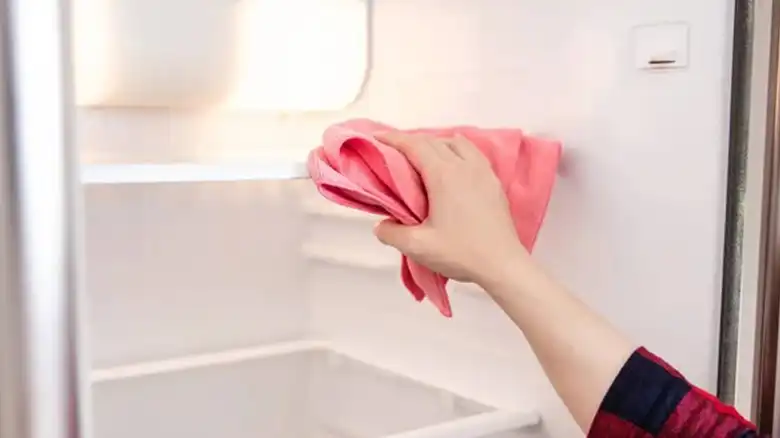
Table of Contents
What’s the Ideal Temperature Setting for an RV Refrigerator?
The optimal temperature settings for an RV refrigerator are –
Refrigerator compartment: Below 40°F (4°C), ideally around 35°F
Freezer compartment: 0°F (-18°C)
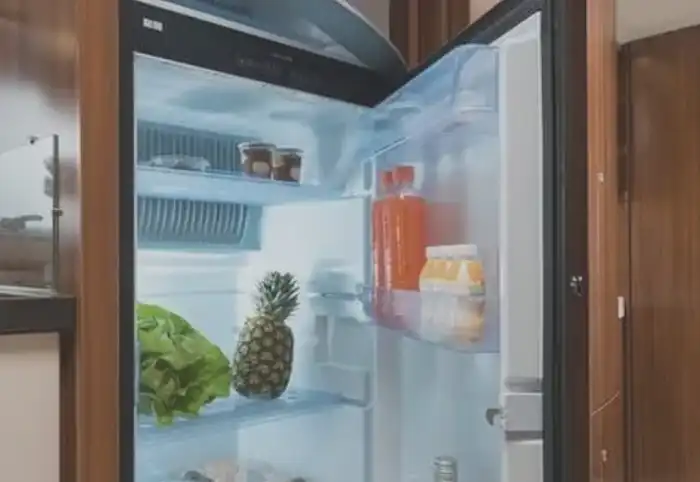
These temperatures slow bacteria growth and prevent food spoilage. The refrigerator area keeps items like produce, eggs, cheese, leftovers, and beverages chilled. The freezer unit allows ice cream, frozen meals, meat, and other goods to stay solidly frozen.
Correct temperatures inhibit microbial growth and preserve food freshness whether plugged in at an RV park or running off battery power boondocking in the wilderness.
How to Check and Monitor RV Refrigerator Temperature?
Frequent temperature checks are key to ensuring your camper refrigerator maintains safe chill levels. The best way to stay on top of monitoring is to use a digital refrigerator thermometer placed inside your RV fridge. This allows you to track the exact interior temperatures. Position the thermometer towards the back center of the compartment, away from the door and walls, to get an accurate ambient reading.
Log the refrigerator and freezer thermometer temperatures at least daily in a notebook or on your phone to detect any fluctuations. If readings start creeping out of the safe zones of below 40°F for the refrigerator and 0°F for the freezer, then gradually tweak the temperature controls to bring it back down. Also check and log temperatures more frequently while traveling or in intense heat, as these conditions tax your RV refrigerator the most. Staying vigilant with temperature tracking ensures no fluctuation issues go unnoticed before they lead to spoiled perishables.
Make checking the thermometer and logging the temps part of your regular RV maintenance routine anytime you hit the road.
How to Adjust RV Refrigerator Temperature Settings?
Most RV refrigerators have manually adjustable thermostats built into the controls to regulate the interior compartments. The location and design of the temperature controls can vary greatly depending on your RV refrigerator model. Most often, there are analog knob adjustments labeled with numerical temperature scales or basic “cold-colder” gradient settings.
To tweak your RV fridge temp, start by turning the knob or pushing the buttons in small increments towards colder outputs. Make minimal temperature shifts at a time and give the fridge a full 24 hours to stabilize and react to the changes before making any additional adjustments. Log your thermometer readings each time and double-check that the number aligns properly with any degrees marked on your fridge controls.
Monitor the thermometer closely to validate that your incremental adjustments are tuning the temperatures back down toward their 35°F and 0°F optimal zones properly. If not, continue gradual tweaks in the cooling direction day by day until safe levels are maintained. Before long outings, turn the RV refrigerator on early and allow ample time for thorough pre-cooling before loading any unchilled food or beverages.
What Affects RV Refrigerator Temperature?
Numerous internal RV factors and external environmental influences can disrupt temperature stability in a camper refrigerator.
Outdoor ambient air temperatures have a major impact, as RV refrigerator coils and lines sit externally with little insulation. Intense heat from the summer sun beating down on an RV taxes refrigerators incredibly hard. Seeking shade in campsites helps mitigate this issue somewhat.
Opening the fridge door frequently also reduces internal chilling drastically. Each time the door opens, all the cooled compartment air escapes which then must be re-chilled. This taxes compressor systems. Having the door ajar too long when sorting items to load or rummaging for a desired food item can also impact temperatures.
Ventilation issues like blocked exterior refrigerator vents, piping, or flues prevent adequate hot air dissipation and reduce efficient operation. Storage items stacked too closely around the exterior fridge roof vents hamper airflow. Inside, shelves overstuffed with food limit internal air circulation.
Parking on off-kilter surfaces tilts refrigerators out of level alignment also decreasing their cooling performance substantially. RV refrigerators lack automatic self-leveling compressors, so uneven ground throwing them out of pitch impacts operation until parked evenly again.
Power source affects output as well. Most RV refrigerators offer both propane gas and 110-volt electric modes. The chosen energy impacts the burner or compressor function, with electricity providing maximum chilling capacity typically.
Cold food storage practices also influence refrigeration temperatures. Adding room-temperature food or chilled beverages warms the interior, requiring extra cooling cycles to compensate, much like opening the door frequently. Stacking items tightly overloads shelves and reduces efficient airflow distribution.
How Do You Ensure Efficient Cooling in Your RV Refrigerator?
Maintaining consistent interior temperatures poses unique challenges for RV refrigeration. Here are tips used by seasoned RV enthusiasts to promote optimal efficiency –
Allow ample lead time before each trip for pre-cooling the empty fridge. Turn it on and give it several hours if not a full day to chill to ideal temperatures before loading anything inside. This allows it to establish the desired ambient degree baseline before it needs to compensate for warmer contents.
Be strategic when stocking the fridge. See if certain items like juice boxes or soda cans are already chilled in your home refrigerator from the garage for instance. Loading colder starting goods reduces strain and prevents temperature spikes. If you’ll be parked with power hookups for a bit before departing, take advantage of moving fridge contents from your household refrigerator directly into the RV unit to give your propane supply a break.
While traveling in extreme heat, consider picking up bags of ice at gas stations to supplement the RV refrigerator’s chilling capacity. Stack items that are most prone to spoiling like meats and dairy around frozen ice packs for concentrated cooling. This hack helped RV pioneers maintain food safety before modern refrigeration existed.
Interior airflow circulation also bolsters consistency. Use a battery-powered portable mini cooler fan inside your RV refrigerator to evenly distribute temperatures from back to front. Strategically place items needing maximum chilling near the rear wall around the coils where it releases cool air. Only fill refrigerator shelves halfway at maximum to enable air to freely move around contents.
When selecting campsites, be diligent by picking sites with shade that will minimize solar heat saturation on your RV if possible. Drape quilts or reflective foil insulation blankets over your RV refrigerator roof vents while parked in intense heat. And avoid opening the fridge except when necessary. Every small habit of retaining cool air rather than needing to re-chill 87-degree exterior air helps efficiency.
Defrosting and Maintaining an RV Refrigerator
For optimal cooling capacity, RV refrigerators need occasional defrosting to prevent ice buildup as well as preventative cleaning.
It’s important to periodically check for frost accumulation, especially around the freezer unit and at the rear by the ventilation coils. Allowing more than 1⁄4 to 1⁄2 an inch of frost buildup to develop causes airflow obstruction issues. Carefully defrost refrigeration components using a plastic scraper if needed to remove excess frost. Shut off the refrigerator overnight without opening the doors to allow the contents to stay chilled. In the morning, the frost should melt sufficiently for removal. Be sure to capture any ice melt leakage with towels rather than letting water drain through crevices into insulation or frameworks.
Wipe down interior shelves and storage boxes regularly with gentle cleaners to keep the inside smelling fresh and prevent sticky spills from gumming up the works. Replace worn door gaskets if they appear cracked or fail to seal properly when closed. Visually inspect piping seals around refrigerant lines for deterioration. Reseal cracks immediately to prevent leaks and loss of coolant.
Having refrigerant liquids recharged by an RV technician annually extends efficiency as gases deplete slowly over years of cycling. For propane gas absorption units, carefully check refrigerant levels per manufacturer specifications before each camping season. Ensure the burner and flues remain clear of combustible debris or dirt buildup which can impact function.
Part of overall RV maintenance should include verifying the refrigerator remains properly leveled when parking. Built-in spirit levels help assess pitch. If askew, use leveling jacks underneath or reinforcement boards beneath wheels to eliminate tilting during prolonged stays. Sitting unevenly ongoing compromises cooling capacity over time.
Establishing periodic refrigerator checks as part of your regular cleaning rhythms keeps the appliance in peak operating condition all camping season long.
Signs of RV Refrigerator Issues
While monitoring refrigerator function, remain alert for the following signs of temperature irregularities or mechanical problems –
a) Reduced cooling effectiveness resulting in interior temperatures creeping above 40°F warns that chilling capacity is dropping. This may show up as food items spoiling quicker than expected.
b) Excess ice sheet buildup beyond normal levels, especially obstructing vents, indicates worrisome airflow disruption issues developing inside.
c) Water droplets or pooling inside the refrigerator compartment or dripping from external outlet hoses signals potential refrigerant seal failures allowing humid air infiltration and moisture accumulation.
d) Unusual vibrations, grinding, buzzing, or knocking noises from the refrigerator unit often suggest a mechanical malfunction requiring investigation. The refrigerant system may have debris fouling a compressor impeller if equipped.
e) Visible cracks in door liners or gaskets, deformed door alignment making complete closure impossible, icy buildup penetrating insulation, water leaks, or uncharacteristic odors point to necessary repairs to ensure peak operation.
Catching and addressing refrigerator problems promptly reduces the likelihood of extensive food waste or dangerous refrigerant leaks. Don’t ignore potential early warning signs.
Troubleshooting RV Fridge Issues
If your camper refrigerator encounters cooling trouble –
Step 1: First, recheck temperature gauge readings inside the unit and adjust the thermostat warmer or colder accordingly if they are no longer calibrated ideally.
Step 2: Thoroughly inspect door seals, internal shelving configurations, and exterior appliance vents for any cracks, air leaks, or blockages letting chilled air rapidly escape. Ensure vents remain debris-free.
Step 3: Evaluate power sources. If equipped for both, check that sufficient propane gas is being burned for absorption cooling operation, or proper voltage is powering the electric compressor functioning.
Step 4: For tilted coaches, re-level the RV by turning down stabilizing jacks if parked on uneven ground to realign the refrigerator.
Step 5: If you find significant frost sheath buildup within the back panel or vents, initiate a manual defrost using the procedures outlined earlier.
Step 6: For persistent cooling issues not resolvable via basic troubleshooting, engage your RV dealer’s certified technician to inspect and professionally service the refrigerator. Thermostatic controls out of calibration, depleted refrigerant levels, or damaged system piping in absorption cooling models may require expert repair.
Identifying the root cause of temperature fluctuations quickly restores reliable chilling performance so you can get back to enjoying a fridge stocked with cold drinks while on summer adventures.
Why is it Important to Maintain the Correct Temperature of the Refrigerator?
Keeping an RV refrigerator compartment at the industry-recommended temperature below 40°F is critical for –
Food safety: Cold temperatures substantially suppress microbial growth which leads to dangerous foodborne illnesses. Maintaining consistent chill preserves edibility and reduces health risks to you and your family while traveling off the grid. Sudden refrigerator failures have led to tragic cases of mass outbreaks from contaminated food storage issues when camping.
Preventing spoilage: Even if not necessarily harboring pathogens, letting refrigerator temperatures fluctuate widely still accelerates food decomposition and shortens edibility periods. The constant expansions and contractions of the contents from excessive shifting between cold states rapidly break down cellular structures. Stable chilled storage preserves freshness allowing the maximum feasible shelf life for RV refrigerator confines.
Operational efficiency: Running an RV refrigerator for prolonged durations above 40°F exacerbates the stress on its cooling systems by necessitating full re-chilling cycles more often. Overworking compressor exhausts energy sources faster, while also accelerating wear on mechanical components and shortening operating lifetime ultimately.
Maintaining vigilance around monitoring refrigerator temperatures ensures it safely stores perishables while delivering peak efficiency. Protect refrigeration function as an essential system for successful RV journeys.
How Do You Maintain an RV Refrigerator Compressor?
Unlike most modern residential refrigerators, RV refrigerators predominantly utilize ammonia absorption technology instead of standard vapor-compression refrigeration. Absorption cooling involves using a combination of ammonia, hydrogen gas, water mixtures, and carefully controlled heat inputs to self-generate a refrigeration cycle rather than employing electric motor-driven compressors.
Maintaining an absorption refrigerator involves –
- Checking ammonia , hydrogen, and water solution levels per factory specifications. Replenishing additives from time to time as gases slowly become depleted through the refrigerant looping process.
- Clearing any debris or obstructions from the exterior refrigerator venting, flues, or chimneys to enable adequate hot air dissipation during the cooling cycle.
- Keeping the propane burner chamber area surrounding absorption units meticulously clean and free of dirt, dust, or grease to prevent combustion issues.
- Testing and adjusting gas jet or electrode ignition functioning annually to sustain reliable activation of the propane burner.
- Inspect internal piping seals routinely throughout the season for deterioration or refrigerant leaks that require resealing to prevent performance issues.
Refer to your RV refrigerator manufacturer guidelines for model-specific recommendations on properly caring for absorption cooling systems before each camping excursion. Maintaining its refrigerant purity and operational heating elements keeps eco-friendly ammonia units pumping for years of loyal service while road-tripping.
Dos and Don’ts While Maintaining Proper Temperature
a) Check refrigerator thermometer and log temps daily
b) Allow ample pre-cool time before trips
c) Load already cold items first when stocking
d) Use ice packs for supplemental cooling
e) Keep vents and doors unobstructed
f) Wipe the interior periodically for freshness
g) Inspect door seals and piping for deterioration
h) Carefully defrost to remove frost buildup
i) Level out RV to keep refrigerator aligned
a) Allow temps to drift out of safe zones
b) Overstuff fridge which hinders airflow
c) Leave doors ajar needlessly
d) Allow vents/flues to become debris clogged
e) Ignore signs of potential mechanical issues
f) Hesitate to adjust controls if readings fluctuate
g) Place hot perishables inside without allowing pre-chilling
h) Overlook manufacturer maintenance guidance
Staying actively attentive to refrigerator functionality keeps food fresh and safe all trip!
Final Thought
While demanding some periodic attention, preserving your RV refrigerator functionality helps ensure many seasons of reliable service keeping food safe and tasty on road trips. Monitor temperatures diligently, adjust as needed for changing conditions, and establish regular interior cleaning and exterior vent maintenance habits. Watch for signs of potential wear on components based on the accumulation of operating hours over extended ownership. Consider preventative professional servicing annually to sniff out emerging issues early before they leave you high and dry without refrigeration out in the wilderness! Apply this awareness to protect and lengthen the duty of this critical appliance so that you can concentrate on enjoying the freedom of RV adventures for years to come.
Relevant Questions
- How often should you check the temperature of an RV refrigerator?
Check RV refrigerator and freezer temperatures at a minimum once daily, if not twice per day whenever possible. This allows you to swiftly catch and resolve any cooling fluctuations before they substantially impact food safety or preservation excessively. Log readings in an onboard notebook or phone app to detect operational patterns over extended travels.
- Why does my RV refrigerator freeze food in the fridge section?
Partial freezing of refrigerated contents like produce, eggs, or beverages indicates the temperature dropped too cold inside the unit. This over-chilling can result from an overactive thermostat setting (well below 35°F), inadequate internal airflow circulation, ineffective door seals admitting external ambient air when closed, or outside wintery air leaking into a poorly insulated cabinet. Adjust the refrigerator temp control knob incrementally upwards towards a warmer spectrum until proper above-freezing chilling resumes around 38°F in the compartment.
- Do RV refrigerators require precise leveling to operate correctly?
Yes, unlike modern household refrigerators, RV absorption cooling refrigerators lack internal self-balancing compressors. They require fixed, external-level installation orientation for the ammonia-based chemicals and gases to evenly circulate. Excess tilt from uneven parking prevents fluids from flowing through piping appropriately. Test your refrigerator for acceptable levelness using built-in spirit level lines. If tilted, place reinforcement boards under the low wheels to align the RV chassis laterally. Leveling is imperative for refrigerator operational success.
Related Posts
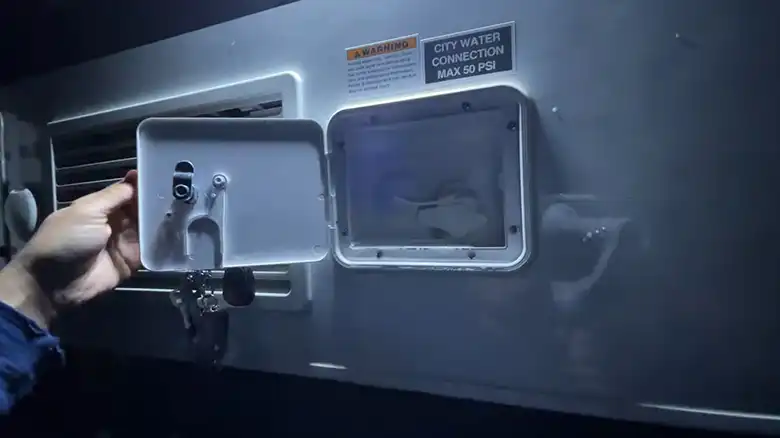
3 Ways to Sanitize an RV Water Tank and Water Lines

6 RV Smells That Could Ruin Your Vacation (and How to Avoid Them!)
Leave a comment cancel reply.
Your email address will not be published. Required fields are marked *
Save my name, email, and website in this browser for the next time I comment.

How to Adjust Temperature on Dometic RV Refrigerator
It’s no longer difficult to keep your meals cold in an RV.
Your food should stay nice and fresh during your RV trip after you understand how to control the temperature.
One approach to maintain your healthy lifestyle when you are away from home is to eat fresh food.
How to Change the Refrigerator’s Temperature on a Dometic RV: When you require colder or warmer temps, it’s simple to change the Dometic brand refrigerator in your RV.
Normally, one of the fins has a little white adjustment handle that takes care of the task for you.
Continue reading to find out how to change the temperature on your Dometic refrigerator.
The knowledge in this post will help you enjoy fresh, cold meals for your whole RV trip.
Temperature Control for the Dometic RV Refrigerator
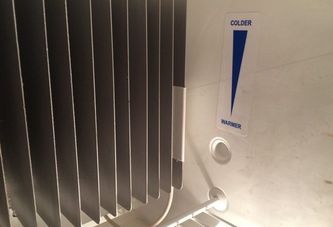
Seeing drops of water pouring down from your freezer is one indication that you need to modify the Dometic refrigerator in your RV.
You need to make the fridge and freezer colder, these drips are telling you.
When ice starts to build in the refrigerator portion of the appliance is another red flag.
The temperature control must now be adjusted to a warmer level.
Resetting the temperature in your Dometic refrigerator is simple.
A little lever that moves up and down on the same fin should be used to regulate the temperature in an RV Dometic refrigerator.
As some people have done, you do not want to shift it side to side.
The temperature inside the refrigerator remains constant despite such movement.
Up and down strokes along the same fin are the proper motion.
Think of up as north to help you recall which way is chilly and which is warm.
Colder weather is to the north.
Then down equals south, and the hotter it gets the farther south you travel.
Dometic Fridge Settings 1 through 5
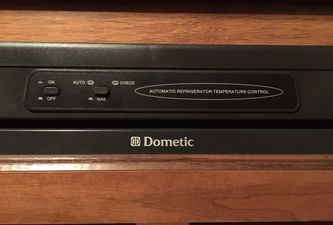
When you modify your RV Dometic fridge, you could not get a lot of range.
There may only be a range of 1 to 5.
Remembering that larger numbers represent colder settings can help you choose the ideal temperature for your meal.
Some folks have discovered that #4 preserves their meals nice and fresh and works best for them.
You can have different results and discover that the center of the dial works best for you.
The more food you keep inside the fridge, the more stable the temperature will be while utilizing the temperature dial or fridge setting.
Use a cheap thermometer to confirm for yourself if your refrigerator is cold or warm if you’re unsure.
What Temperature Should an RV Refrigerator Be at?
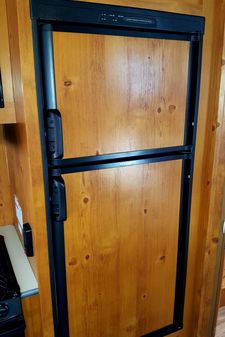
You could mistakenly believe that the Dometic refrigerator in your RV is different from the one in your house.
Both of them function as essentially the same unit.
This implies that the optimal refrigerator temperature for your house and your RV are the same.
The recommended RV refrigerator temperature is from 40 to 42 degrees Fahrenheit.
If the temperature is not dropping that low, either you have the temperature control set too high or your refrigerator is broken.
You can keep food cold at temperatures lower than 40 degrees, but you shouldn’t go below 35 degrees F since then it will freeze.
Using a fish tank thermometer and setting it in a jar of water is one method to verify the consistency of the temperature in your refrigerator.
Make sure the thermometer is completely covered before screwing on the lid on the jar.
Place the jar in the refrigerator, shut the door, and wait.
When you check the thermometer later, you ought to obtain a precise measurement on how well your refrigerator is maintaining temperature.
Temperatures That Are Tolerable in a Dometic Fridge (Average RV Refrigerator Temp)
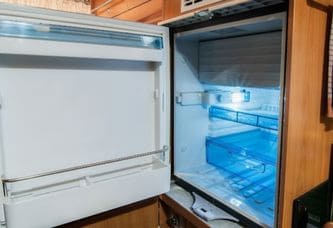
As previously mentioned, the Dometic refrigerator in your RV works best when the temperature is between 40 and 42 degrees F.
But sometimes it’s difficult to maintain the ideal, or you could have mistakenly set the thermostat too high or too low.
Since you have considerable flexibility in temperature ranges, none of those circumstances is very problematic.
You shouldn’t allow an RV Dometic fridge to become warmer than 50 degrees F.
Simply said, it is dangerous to keep cold food at high temperatures.
On the allowable temperature scale, 35 degrees F is the lowest value.
As was previously indicated, food may freeze at lower temperatures, destroying it or making it dangerous to consume.
Ideal for the freezer is 0 degrees F.
Temperatures between 10 and 20 degrees F are likewise okay, however you may go as high as 30 if you wish.
When Does a Dometic Refrigerator Start to Cool?
This will depend on the power source you utilize and the Dometic refrigerator model.
Some individuals have experienced a 24-hour delay before their refrigerator became cold enough to store food.
Others discovered that adding ice to their refrigerators made it take anything from 3 to 12 hours for the temperature to drop to the desired level.
It’s also possible that 8 hours will pass.
Your experience will probably vary depending on a number of variables.
Ice is often used by people to speed up the cooling process.
Final Thoughts
It’s not that tough to get your Dometic RV fridge to operate correctly.
Even if it takes a little time, it is ultimately worthwhile.
You should be alright if you get how the temperature control works (up and down) and which level is the coldest, greater numbers.
You should be OK as long as your Dometic refrigerator is operating at the recommended temperature setting of 40 to 42 degrees F or stays within the permitted temperature range of 35 to 50 degrees F.
Consult your owner’s handbook if you have any queries about the proper settings.
Always keep in mind that there are methods you may use to guarantee your refrigerator is operating as it should.
Dometic RV Refrigerator Settings 1 5 Videos Suggestions From Youtube
Updated on May 5, 2023
Meet Bob & Sarah

We're Bob & Sarah, the RVers behind RVing Beginner. We love RV travel, useful gear, and all things nature. Read more…
About Us - Contact Us - Privacy Policy - Terms Of Service - Affiliate Disclosure - Sitemap
Copyright © RVing Beginner 2022


IMAGES
VIDEO
COMMENTS
One sign that you need to adjust your RV’s Dometic fridge is seeing drips of water coming down from your freezer. This drips tell you that you need to make the fridge and freezer cooler. Another sign is whe…
Adjust the temperature of your RV refrigerator to ensure optimal cooling. …
Your RV’s refrigerator should be less than 40 degrees Fahrenheit (4 deg C), ideally around 35 degrees. Setting your fridge’s temperature will vary depending on the brand but adding a thermometer will help you know if your fridge is set …
To adjust the temperature of your RV refrigerator, follow these steps: Find the temperature control panel. Set the temperature to your preferred level using the colder-warmer settings. Use a thermometer to check the temperature inside …
Using the Dometic RV fridge for the first time: The ideal interior fridge temperature …
Become a Patron: https://www.patreon.com/myrvworksParts and Tools Links: https://myrvworks.com/resources/darrens-tool-list/Service Manuals: https://myrvwo...
However, as a general guideline, it’s recommended to maintain your RV fridge temperature between 34°F and 40°F (1.11°C and 4.44°C) to keep perishable food fresh and safe to consume. The recommended temperature for …
Learn how to maintain proper temperature in your RV refrigerator. Tips for monitoring, adjusting, and troubleshooting to ensure food safety while camping.
As far as I know, there is no temperature-controlled refrigerant valving between the freezer and refrigerator evaporators, and no separate sensor in the freezer. So when the cooling is ‘ON’ more due to the sensor reposition, …
You should be OK as long as your Dometic refrigerator is operating at the recommended temperature setting of 40 to 42 degrees F or stays within the permitted temperature range of 35 to 50 degrees F. Consult your owner’s …